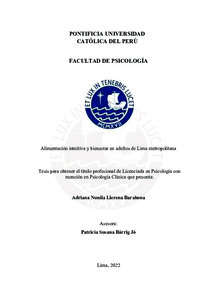| dc.contributor.advisor | Bárrig Jó, Patricia Susana | |
| dc.contributor.author | Llerena Barahona, Adriana Nunila | |
| dc.date.accessioned | 2023-03-08T20:43:38Z | |
| dc.date.available | 2023-03-08T20:43:38Z | |
| dc.date.created | 2022 | |
| dc.date.issued | 2023-03-08 | |
| dc.identifier.uri | http://hdl.handle.net/20.500.12404/24452 | |
| dc.description.abstract | El propósito de este estudio fue explorar la asociación entre alimentación intuitiva (AI) y
bienestar, tomando como base una muestra por conveniencia de 187 adultos (71 hombres y
116 mujeres, de entre 20 a 38 años (M=24.18, DE=4.52)). Con este objetivo, se aplicaron
de manera virtual las escalas de Alimentación Intuitiva (Romero, 2018), SPANE y
Florecimiento (Cassaretto & Martínez, 2017). De acuerdo con los objetivos del estudio se
encuentra que: a) Existe una relación positiva y mediana entre la AI global, el afecto positivo
y el florecimiento, así como una relación inversa y pequeña entre la AI global y el afecto
negativo. b) No existen diferencias en AI global entre hombres y mujeres, pero se encuentra
evidencia de mayores puntajes en CRF y ECC en hombres. c) No se encuentran diferencias
en AI global según la costumbre de hacer dieta, pero sí dentro de sus dimensiones. De esto
modo, quienes no hacen dieta, presentan mayores niveles de PIC y menores niveles de ECC
respecto a quienes sí hacen dietas. | es_ES |
| dc.description.abstract | The purpose of this study was to explore the association between intuitive eating (AI) and
well-being, based on a convenience sample of 187 adults (71 men and 116 women, aged 20
to 38 years (M=24.18, SD=4.52). With this objective, the Intuitive Eating (Romero, 2018),
SPANE and Flourishing (Cassaretto & Martínez, 2017) scales were applied virtually.
According to the objectives of the study, it is found that: a) There is a positive and medium
relationship between global IE, positive affect and flourishing, as well as an inverse and
small relationship between global IE and negative affect. b) There are no differences in
global IE between men and women, but there is evidence of higher scores in EPR and BCC
in men. c) No differences were found in global IE according to the habit of dieting, but there
were differences within its dimensions. In this way, those who did not diet show higher levels
of UPE and lower levels of BCC when compared to those who diet. | es_ES |
| dc.language.iso | spa | es_ES |
| dc.publisher | Pontificia Universidad Católica del Perú | es_ES |
| dc.rights | info:eu-repo/semantics/openAccess | es_ES |
| dc.rights.uri | http://creativecommons.org/licenses/by-sa/2.5/pe/ | * |
| dc.subject | Bienestar | es_ES |
| dc.subject | Hábitos alimenticios | es_ES |
| dc.subject | Adultos jóvenes--Perú--Lima | es_ES |
| dc.title | Alimentación intuitiva y bienestar en adultos de Lima metropolitana | es_ES |
| dc.type | info:eu-repo/semantics/bachelorThesis | es_ES |
| thesis.degree.name | Licenciado en Psicología con mención en Psicología Clínica | es_ES |
| thesis.degree.level | Título Profesional | es_ES |
| thesis.degree.grantor | Pontificia Universidad Católica del Perú. Facultad de Psicología | es_ES |
| thesis.degree.discipline | Psicología con mención en Psicología Clínica | es_ES |
| renati.advisor.dni | 09391905 | |
| renati.advisor.orcid | https://orcid.org/0000-0003-4685-5760 | es_ES |
| renati.author.dni | 70042842 | |
| renati.discipline | 313026 | es_ES |
| renati.juror | Bárrig Jó, Patricia Susana | es_ES |
| renati.juror | Anaya Rosales, Rogger Holfre | es_ES |
| renati.juror | Cassaretto Bardales, Mónica de los Milagros | es_ES |
| renati.level | https://purl.org/pe-repo/renati/level#tituloProfesional | es_ES |
| renati.type | https://purl.org/pe-repo/renati/type#tesis | es_ES |
| dc.publisher.country | PE | es_ES |
| dc.subject.ocde | https://purl.org/pe-repo/ocde/ford#5.01.00 | es_ES |







